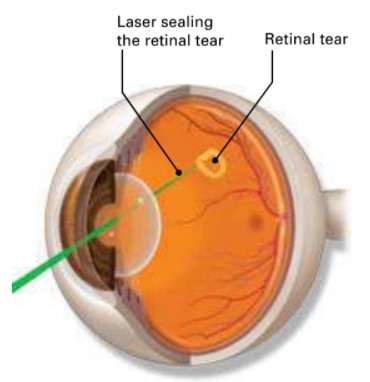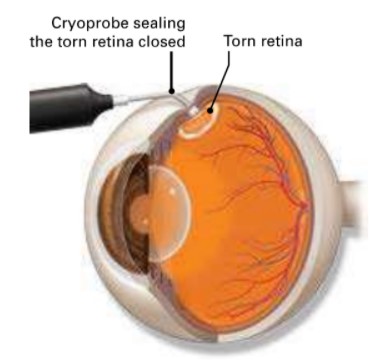What is a torn retina?
A torn retina is a serious problem that makes your vision blurry. It is when the retina has a tear or hole, like a rip in cloth. A torn retina often leads to a more serious condition called a detached retina. This is where the retina is lifted away from the back of the eye. A torn retina must be treated right away to avoid further vision problems.
How do you get a torn retina?
As we get older, the vitreous in our eyes starts to shrink and get thinner. Usually the vitreous moves around on the retina without causing problems. But the vitreous may stick to the retina and pull hard enough to tear it. When that happens, fluid can pass through the tear and lift (detach) the retina.
When the retina tears, you may suddenly see flashes of light or floaters. Sometimes blood can leak into the vitreous. This is called a vitreous hemorrhage, and it can cause a large number of floaters.
With a torn retina, fluid may leak through the hole and detach the retina. This serious problem must be treated right away or you could
lose vision.

® Eye Words to Know
Retina: Layer of cells lining the back wall inside the eye. This layer senses light and sends signals to the brain so you can see.
Vitreous: Jelly-like substance that fills the middle of the eye.
Floaters: Tiny clumps of cells or other material inside the vitreous. These look like small specks, strings or clouds moving in your field of vision.
Who is at risk for a torn retina?
Here are some things that put you at risk for having a torn retina:
- Needing glasses to see far away (nearsighted)
- Having had previous cataract, glaucoma, or other eye surgery
- Taking glaucoma medications that make the pupil small (like pilocarpine)
- Having had a serious eye injury
- Having a retinal tear or detachment in the other eye
- Having family members with retinal detachment
- Having weak areas in the retina (which your ophthalmologist may see during an exam)
Early signs of a retinal tear
A torn retina has to be checked by an ophthalmologist right away. Otherwise, your retina could detach and you could lose vision in that eye. Call an ophthalmologist immediately if you have any of these signs:
- You see flashing lights. Some people say this is like seeing stars after being hit in the eye.
- You notice many new floaters.
- A shadow appears in your peripheral (side) vision.
- A gray curtain covers part of your field of vision.

How is a retinal tear diagnosed?
Your ophthalmologist will put drops in your eye to dilate (widen) the pupil. He or she then will look through a special lens to see any changes inside the eye. This is the best way to see if you have a retinal tear or early retinal detachment.
How are retinal tears treated?
There are two ways your eye surgeon may fix your retinal tear.
Photocoagulation: A laser is used to seal the retina to the wall of the eye. The goal is to keep fluid from going through the tear and detaching the retina The treatment usually takes less than 15 minutes. It may be done right in your ophthalmologist’s office. Your ophthalmologist puts a lens on the front of your eye to focus the laser. He or she then makes tiny burns with the laser to form scars. The scars seal the retina to the wall of the eye.
Cryopexy: Extreme cold is used to seal the retina to the wall of the eye. The goal is to keep fluid from going through the tear and detaching the retina.
This treatment usually takes less than 30 minutes. It may be done right in your ophthalmologist’s office. The surgeon uses a special probe that delivers intense cold energy to the retina. This freezes the retina around the tear and creates scar tissue. The scars seal the retina to the eye wall.

What are retinal tear surgery risks?
Like any surgery, retinal tear surgery has risks. Following are some of these risks.
- Eye infection
- Bleeding in your eye
- Glaucoma, when pressure increases inside the eye
- Cataract, when the lens in your eye becomes cloudy
- The need for a second surgery
- The possibility that the retinal tear does not close
Your ophthalmologist will discuss these and other risks and how surgery can help you.
What should I expect after surgery for a retinal tear?
- You might have some pain for a few hours after surgery. You may take over-the-counter pain medication to help you feel better.
- You will need to rest and be less active after surgery for a few weeks. Your ophthalmologist will tell you when you can exercise, drive or do other things again.
- You may need to wear an eye patch after surgery. Be sure to wear it as long as your doctor tells you to.
- You might see floaters and flashing lights for a few weeks after surgery.
Summary
A torn retina is when you have a hole or tear in your retina, like a rip in a piece of cloth. This is a serious problem that must be treated right away. Symptoms include seeing a lot of floaters and flashes suddenly, as well as vision loss. It is treated with surgery.
If you have any questions about your eyes or your vision, speak with your ophthalmologist. He or she is committed to protecting your sight.
Watch a torn or detached retina video from the American Academy of Ophthalmology’s EyeSmart program at aao.org/torn-retina-link.
